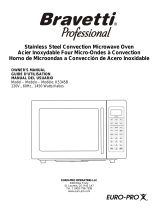
14
Manual Defrosting
If the food that you want to defrost is not listed in the “Sensor
Defrost Chart” or is above or below the range of amounts shown
in the chart, you need to defrost manually.
You can defrost any frozen food, either raw or previously cooked,
by using Power Level 3. Follow the exact 3-step procedure found
in the “Time Cooking” section. Estimate defrosting time and touch
“3” for 30% when you select the power level.
For either raw or previously cooked frozen food, the rule of thumb
is approximately 5 minutes per pound. For example, defrost
5 minutes for 1 pound of frozen spaghetti sauce.
Always stop the microwave oven periodically to remove or
separate the portions that are defrosted. If food is not defrosted at
the end of the estimated defrosting time, program the microwave
oven in 1-minute increments at Power Level 3 until totally
defrosted.
When using plastic containers from the freezer, defrost only
long enough to remove from the plastic in order to place in a
microwave-safe dish.
Sensor Cooking
A sensor in the microwave oven detects humidity released from
the food as it heats and adjusts the cook time accordingly.
Many sensor cycles require the covering of foods.
Microwave-safe containers or steamers with loose-fitting lids
are recommended. The loose-fitting lid allows enough steam to
escape to be detected by the sensor. When covering foods with
plastic wrap, be sure to leave a large enough vent opening to
allow the steam to escape. This will allow the sensor to accurately
determine cooking time.
Using Sensor:
■ After the microwave oven is plugged in, wait 3 minutes before
using sensor settings.
■ Be sure the exterior of the cooking container and the interior of
the microwave oven are dry. Wipe off any moisture with a dry
cloth or paper towel.
■ The room temperature should not exceed 95°F (35°C).
■ Reheat and Popcorn can only be entered within 1 minute
after cooking, opening and closing the door, or touching
STOP/CLEAR.
■ During the first part of sensor cooking, the food name will
appear on the display. Do not open the microwave oven door
or touch STOP/CLEAR during this part of the cooking cycle.
The measurement of vapor will be interrupted. If this occurs,
an error message will appear. To continue cooking, touch
STOP/CLEAR and select cooking time and variable power.
■ When the sensor detects the vapor emitted from the food, the
remainder of cooking time will appear. Door may be opened
when the remaining cooking time appears on the display. At
this time, you may stir or season food as desired.
■ Check food for temperature after cooking. If additional time
is needed, continue to cook with variable power and time.
■ If the sensor does not detect vapor properly when popping
popcorn, the microwave oven will turn off and the correct time
of day will be displayed. If the sensor does not detect vapor
properly when using sensor reheat, “ERROR” will be displayed
and the microwave oven will turn off.
■ Any Sensor Cooking mode can be programmed with More
or Less Time Adjustment. See the “More or Less Time
Adjustment” section.
■ Each food has a cooking hint. Touch HELP when the Help
indicator is lit in the display.
Selecting Foods:
■ The sensor works with foods at normal storage temperature.
For example, food for dinner plate reheating would be at
refrigerator temperature and popcorn would be at room
temperature.
■ Foods weighing less than 3 ounces should be reheated by
time and variable power.
Instant Sensors
Your microwave oven has Instant Sensor Popcorn and Instant
Sensor Reheat. To use either, touch the corresponding keypad.
The microwave oven will start automatically.
Sensor Reheat
You can reheat many foods by touching just 1 keypad.
It is unnecessary to calculate reheating time or power level.
To set:
1. Touch REHEAT.
When the sensor detects the vapor emitted from the food,
the remainder of reheating time will appear.
IMPORTANT: Slowly remove any covering to allow steam
to escape away from you.
Popcorn
The sensor in the microwave oven determines the appropriate
popping time of commercially packaged microwavable popcorn.
This function is programmed to detect popping times for 3.5 oz
(99 g), 3.0 oz (85 g), and 1.75 oz (50 g) bags.
NOTE: During Sensor Popcorn function, as with all microwave
cooking functions, the microwave oven should be attended at all
times. Listen for popping to slow to 1 pop every 1 or 2 seconds,
then stop the cycle.
■ To avoid damage to the microwave oven, do not use regular
paper bags or glassware.
■ Pop only 1 package of popcorn at a time.
■ Follow manufacturer’s instructions when using a microwave
popcorn popper.
■ For best cooking results, do not try to pop unpopped kernels.
■ Use fresh bags of popcorn for optimal results.
■ Cooking results may vary by brand and fat content. For bag
sizes not listed in this section, follow package directions.
To set:
1. Touch POPCORN once for a 3.0–3.5 oz. bag or twice for
a 1.5–1.75 oz. bag.
Instant Sensor Chart
FOOD AMOUNT PROCEDURE
Sensor
Reheat
Leftovers
such as rice,
potatoes,
vegetables,
casserole
4–36 oz
(0.12–1.0 kg)
Place food on microwave-safe
plate, cover with plastic wrap,
and vent.
Soups 1–4 cups Place in microwave-safe
container, cover with plastic
wrap, and vent. Stir, recover,
and let stand 2–3 minutes
after reheating is complete.
Canned
entrees
and
vegetables
4–36 oz
(0.12–1.0 kg)
Use Less Time Adjustment by
touching POWER LEVEL twice
for small quantities of canned
vegetables.




















 Euro-Pro Microwave Oven K5345B Manuel utilisateur
Euro-Pro Microwave Oven K5345B Manuel utilisateur